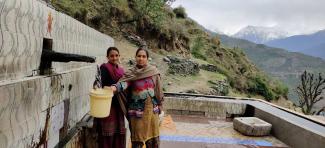Springshed management
Save the Himalayan springs
 Nand Kishor Agrawal/ICIMOD
Spring in the Indian state of Himachal Pradesh.
Nand Kishor Agrawal/ICIMOD
Spring in the Indian state of Himachal Pradesh.
Phulmaya Devi lives in the village of Phulbari in central southern Nepal. The elderly woman is known to the villagers as “Spring Aama” (“Spring Mother”). She realised that if her community did not learn how to properly manage their springs, they would soon dry up. After attending a training programme on spring revival, Phulmaya Devi not only rejuvenated springs in her village, but also inspired people in other villages to do the same.
Across the Himalaya, people unite to revive springs relying on basic training, technical assistance and locally mobilised funding. In the village of Khetikhan in northern India, for example, a group of women, supported by a local non-governmental organisation (NGO), saved a spring from drying by conserving its catchment area. The availability of additional water inspired the village headman to plan for piped water supply and household water connections.
Springs are important for local people
People in the Himalayas depend on springs – for domestic water use, small-scale irrigation and cultural reasons too. They know there are no easy alternatives in the mountainous terrain. It is usually women who fetch water for domestic use. If they lack nearby sources, they must travel long distances, often carrying water uphill. Some communities have resorted to pumping water from nearby rivers. However, this is costly and energy-intensive and often not feasible for remote settlements.
There is no complete inventory of springs for the Hindu Kush Himalayan region, encompassing Afghanistan, Bangladesh, Bhutan, China, India, Myanmar, Nepal and Pakistan. According to rough estimates there are about 9 million springs sustaining over 100 million people. Inventories indicate that each spring in inhabited areas serves at least 10 households.
During the dry season, which can last six to eight months, most springs typically discharge about one litre or more per minute. Conservative estimates suggest that about half of all springs in the Hindu Kush Himalayan region are close to human settlements. This would mean that 4.5 million springs provide about 6,500 million litres of water per day.
Springs are running dry
In 2018, about half of the estimated 3 million springs in the Indian Himalayan region had either dried up or reduced flows, according to NITI (National Institution for Transforming India) Aayog, the Indian government’s public policy think tank. In Bhutan, a 2022 assessment of more than 6,500 water sources found that about 35 % were drying up. Nepal faces a similar situation, impacting around 10 million people relying on springs.
One reason why springs are drying up is that ponds, which once stored water or served as wallows for livestock, have fallen into disrepair. Moreover, in the Hindu Kush Himalayan region, many water planners are only trained to design water supply infrastructure, not to recognise and safeguard water resources or recharge areas.
Other main reasons for the degradation of springs are:
- climate change and variability in weather patterns, particularly erratic rainfall and snowfall,
- deforestation,
- road infrastructure development,
- groundwater withdrawal and
- natural causes like earthquakes.
Moreover, compared to a watershed that may easily cover about 400 hectares, springs are small units of typically one to five hectares. Planners tend to neglect them as an important source of water in the larger context of rivers, watersheds and aquifers.
Prevention is crucial
Preventing further degradation should be top priority for governments and communities. Speed and scale are of utmost importance. However, limited funding and technical capacities often hinder prevention. Bureaucracy, hierarchies and political priorities also play a role. Governments tend to prioritise quick technical fixes over preventive measures, despite the urgency of averting a future crisis.
Proper springshed management is urgently needed. It is an emerging field, covering both the management of the sources (springs) and the underground area, where water is stored and supplied to the springs. Springshed management differs from watershed management, since underground hydrogeology is very different from what appears on the surface. For example, watershed efforts can result in additional groundwater storage and flow, but not necessarily to the targeted spring. It is praiseworthy that the Indian government has included springsheds in its recent watershed guidelines, albeit mostly from a watershed management perspective.
Governments of the countries of the Hindu Kush Himalayan region demonstrate commitment through budgets, plans and success stories, but tend to focus on degraded springs. However, unless prevention receives equal attention, numerous springs could dry out. Springs are currently being revived slower than they are drying up.
Preventing spring depletion requires sustainable land management. It is not enough to simply protect areas close to springs with fences and trees. We also need to identify areas where groundwater enters the soil and is contained between layers of rocks. Such areas can be located in other villages or catchments. Therefore, close collaboration between spring communities and stakeholders in recharge areas is essential. This can be difficult, however, and may require incentives.
Priority steps
Taking action on springs starts with mapping. This can be an empowering process for communities as they gain a better understanding of springs and their hydrogeology. With the help of mobile apps and field test kits, they can report information about the location of the spring or the water quality, for example. This will result in a more complete inventory and a clearer picture of the condition of the springs.
Secondly, raising awareness is crucial. Springshed management should be taught in schools. Local governments must invest in training workers instead of expensive treatments. They must educate community members about hydrology and geology, so that they can help local governments make investment decisions. This could be supported by simple decision tools and standard protocols for springshed management.
Thirdly, strong governance, gender equality and social inclusion as well as fair benefit sharing are vital for sustainable community-level projects. Where systematic community mobilisation is lacking, springshed interventions often remain limited to technical aspects, risking their long-term success – quite like a short-term fix that is unlikely to prevent relapse.
Progress and failure
There has been some progress in the coverage of drinking-water supply systems and connections, particularly in India. However, state agencies of the Himalayan states should be more involved in conserving and managing water sources. Better coordination is needed between these agencies to unite conservation and supply efforts. Communities must play an active role in both, taking ownership rather than just being supplied with water.
Furthermore, climate change impacts on springs have not been adequately studied yet. The climate discourse often focuses on melting glaciers, floods and other extreme events. Springs should not be forgotten, however. After all, they provide water for millions of households and support Himalayan rivers, on which some 2 billion people downstream depend. Scaling up springshed conservation can benefit nature and people by restoring biodiversity, reducing the impacts of climate change and sustaining livelihoods.
Water security in the Himalaya is at a tipping point. We must act together with speed and scale to revive drying springs and avert an impending crisis of water stress in the not-so-distant future, which could lead to widespread dislocation, loss of livelihoods and conflict. In the language of economics, an ounce of prevention is worth a pound of cure. We cannot afford to wait.
Literature
Gupta, A., Kulkarni, H., 2018: Report of Working Group I – Inventory and revival of springs in the Himalayas for water security.
https://lib.icimod.org/record/34336
Liniger, H., Bandy, J., Bhuchar, S., Joshi, R., 2020: Spring revival with sustainable land management (SLM) in the Himalayan foothills: Uttarakhand, North India. WOCAT SLM Policy Brief, No. 1. Bern, Switzerland, CDE.
https://www.wocat.net/documents/1056/high_with_references_online_DEF_WOCAT_Policy_Brief_India.pdf
Nand Kishor Agrawal is Strategic Group Lead on Shaping Green and Resilient Mountain Economies at the International Centre for Integrated Mountain Development (ICIMOD) in Kathmandu.
nandkishor.agrawal@icimod.org
Sanjeev Bhuchar is Senior Watershed Management Specialist at ICIMOD.
sanjeev.bhuchar@icimod.org
The authors thank Samuel Thomas and Gillian Summers for their contributions to this article.



